Community Order in Japanese Agriculture
Yoshihisa Godo
Professor, Meiji Gakuin University, Japan
Community order and free-market competition
Japanese agriculture is not sustainable without community order. To understand the importance of community order, it is useful to briefly review the geographical and climatic characteristics of Japan.
In Japan, there is huge rainfall in the mountainous areas. Annual precipitation in Japan is 1,728 millimeters. That is more than twice the precipitation of France (750 millimeters), which is one of the biggest agricultural countries of the EU. Only 33% of the total land acreage in Japan is flat, which is much smaller than that of other major developed countries (e.g., 70% in the United States, 90% in the United Kingdom, 77% in Italy, 73% in France, and 69% in Germany).
Rivers in Japan are steep and short. Water from rainfall quickly runs into the ocean. The water levels of rivers change widely and continuously according to the weather. Moreover, all of the farmers in a community use the same irrigation channel. Parcels of farmland adhere to each other closely. Thus, farmers must collaborate in irrigation and the extermination of insect pests. Collaboration among farmers is particularly important in rice farming. In the flood irrigation of rice paddy fields, water moves in order from the upper parcels to the lower ones. Inappropriate use of water and agricultural land in one paddy field parcel can adversely affect all farmers in the community.
Traditionally, each community had various detailed rules on how to use water and agricultural land as part of the community order. Such rules were seldom codified as written laws. However, in the pre-war period, farmers took community order for granted as they were bound up with old customs. During the Pacific War, to support the war economy the government suppressed individualism through thought control. As a result, the enforcement of community order was strengthened during that time. The situation changed drastically, however, after the Pacific War. The occupying authorities introduced free-market competition and individualism into Japanese society. Even after sovereignty was restored in 1952, Japan continued to support the ideology of free-market competition and individualism as a member of the capitalist bloc.
In most manufacturing-sector businesses, simple free-market competition among individual producers can improve the industry by causing inefficient producers to exit the market and efficient producers to remain. In the case of agriculture, however, if individual farmers compete with each other without observing community order, none of them can farm efficiently. Thus, coordinating community order in the context of free-market competition is one of the most difficult problems in current agricultural policy.
JA’s role in organizing community order until the early 1990s
From the end of the Pacific War until the early 1990s, the agricultural cooperative system, known as JA,[i] played a key role in preserving community order. JA was established in 1947 as a new system of mutual assistance for farmers. Compared with agricultural cooperatives in other developed countries in Europe, North America, and Australasia, JA has two distinct features. First, JA has a three-layer nationwide pyramid structure: village, prefecture, and nation. All village farmers belong to a local unit of JA. The local JA units in a prefecture form a prefectural federation of JA. Then, the prefectural federations throughout Japan form the central JA federation. This structure resembles the system of Japanese administration. Second, in addition to agriculture-related services, JA provides various daily-life economic services such as banking (JA Bank), retailing of consumption goods (supermarkets), arrangement of family ceremonies, ticketing for travel, and car dealing.
In addition to these two characteristics, JA had two other characteristics up until the early 1990s. First, JA maintained strong ties with the Liberal Democratic Party (LDP), which had stayed in power almost entirely since its inauguration in 1955. JA was known as one of the most consistent long-term supporters of the LDP. Second, JA received various privileges in its economic activities from the government. For example, JA had been granted exclusive rights in the procurement of rice from farmers under the Staple Food Control Act of 1942.
With such strong political and economic power, JA functioned as an organizer of community order. JA supervised the farmland and water usage of its member farmers. Under the leadership of JA, all farmers in the community participated in various collective actions, such as cleaning joint-use irrigation canals.
There are two faults in the way JA organized community order. First, JA sometimes overemphasized equality among its member farmers. As a result, JA’s activities sometimes caused inefficiency. For example, JA preferred to sell agricultural products at the same price, ignoring differences in skills among farmers. Second, JA’s leadership was not organized under any written law. As long as JA kept strong ties with farmers, community order would be maintained under its leadership. However, the relationship between JA and farmers was subject to change depending on economic and political conditions. In that sense, JA’s leadership of community order was delicate and could not be expected to last long.
The decline in JA’s organizational abilities since the early 1990s
In the early 1990s, JA was affected by changes in economic and political conditions. First, the government implemented deregulation policies. As a result, JA lost its privileges in the distribution of agricultural commodities. In particular, the abolishment of the Staple Food Control Act in 1994 deprived JA of its monopolistic position in the collection of rice. In addition, the liberalization of interest rates on small-amount deposits, launched in 1989, damaged JA’s banking business, which had produced the largest part of JA’s profits. Second, the Lower House election was reformed in 1994. With this election reform, the former multi-seat constituency system was replaced by a single-seat system. In the former multi-seat system, the LDP needed to segment supporters’ votes by returning multiple lawmakers in a single constituency. To do so, the LDP relied on JA’s ability to segment farmers’ votes. However, under the new election system, the LDP no longer needed to segment supporters’ votes in a single constituency. In addition, with this reform more seats were allocated to urban areas than rural. This also weakened JA’s importance as a voting group.
To cope with these new economic and political conditions, JA launched various structural reforms. For example, JA consolidated small local units into larger ones to strengthen its financial abilities. JA also aggressively promoted its businesses to non-farmers in rural areas. Despite these efforts, JA could not maintain the strong presence it once commanded. JA has continued to decline in its ability to organize member farmers since the early 1990s. Accordingly, it is getting more and more difficult for JA to maintain strong leadership in keeping community order.
Illustration of the deterioration of community order
It will be useful to illustrate the deterioration of community order with figures. Figure 1 shows the situation of Japanese rural society before the Pacific War. During that time, the assertion of private rights was restricted under the Constitution of the Empire of Japan, and the administration system was largely organized in a top-down fashion. At the same time, community order was observed on the basis of old customs. Figure 2 shows Western-style democratic society. There, citizens are allowed to assert their private rights under a democratic constitution. Simultaneously, citizens bear the responsibility for establishing and enforcing community rules. After the Pacific War, Japan tried to democratize its society. Japanese society, however, made the mistake of copying only the assertion private rights without introducing citizen responsibility (Figure 3). As long as JA played the role of organizing community order, such order was maintained to some extent. However, given that JA’s organizing abilities have been in decline since the 1990s, community order is now collapsing (Figure 4).
The “Program for Conserving Agricultural Land, Water, and Environment”
The deterioration of community order has become a serious problem in Japanese agriculture. Selfish use of agricultural land and water is common. Fewer farmers participate in maintaining community waterways and roads. As such, Japanese agricultural performance is worsening.
As a countermeasure for this deterioration, the government launched a new program called the “Program for Conserving Agricultural Land, Water, and Environment” in 2007. This program encourages rural people to set up new organizations that manage community activities. There are two types of these organizations. One is Katsudo Soshiki (Organization for Community Activities), and the other is Nouchi Mizu Kankyo Hozen Soshiki (Organization for Conserving Agricultural Land and Water). The functions and objectives of the two types of organizations are basically the same. The major difference between the Katsudo Soshiki and the Nouchi Mizu Kankyo Hozen Soshiki is size; the latter is suitable for the municipal unit (city, town, or village), while the former is suitable for smaller units. The major function of both is to organize rural community activities that conserve local common resources such as water and landscape. Both organizations must include not only farmers but also nonfarmers who live in the rural community. This is because farmers and nonfarmers are mixed in today’s rural community, and collaboration between them is necessary for efficient planning in land and water use. The government provides subsidies, called “Payment for Conserving Agricultural Land and Water,” to support the activities of the Katsudo Soshiki and the Nouchi Mizu Kankyo Hozen Soshiki. The records of these subsidies are shown in Tables 1 and 2.
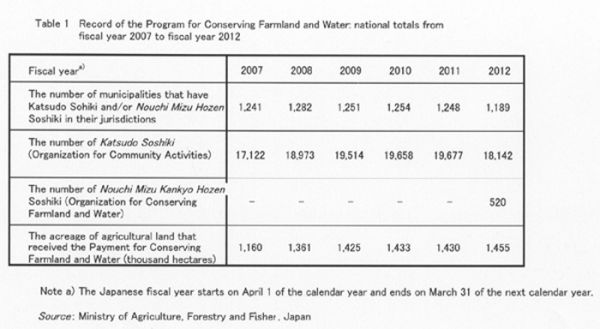
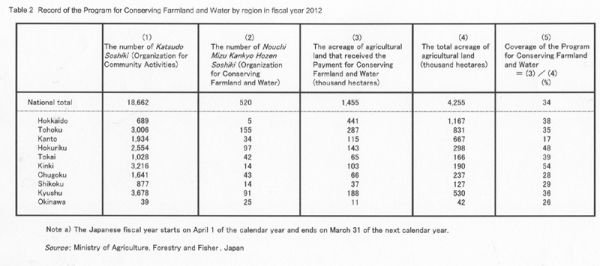
Fig. 1. The Japanese rural society before the Pacific War

Fig. 2. The western-style democratic society
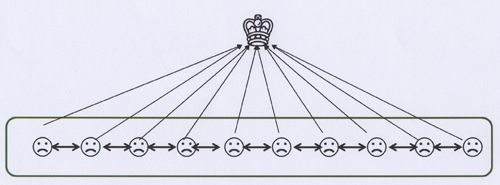
Fig. 3. The Japanese rural society in the postwar high growth year
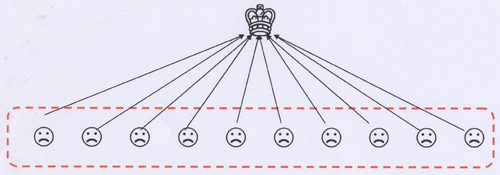
Fig. 4. The Japanese rural society since the 1990s
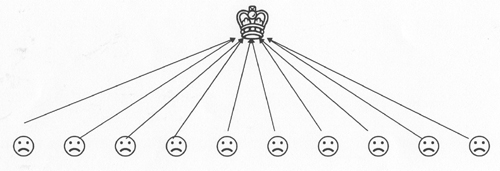
|
Date submitted: December 22, 2013
Reviewed, edited and uploaded: December 30, 2013
|
[i] JA was coined by combining Japan and agriculture. Since 1992, the name JA has been used as the nickname of the system of Japanese agricultural cooperatives. Before 1992, it was called Keito.


Community Order in Japanese Agriculture
Community Order in Japanese Agriculture
Yoshihisa Godo
Professor, Meiji Gakuin University, Japan
Community order and free-market competition
Japanese agriculture is not sustainable without community order. To understand the importance of community order, it is useful to briefly review the geographical and climatic characteristics of Japan.
In Japan, there is huge rainfall in the mountainous areas. Annual precipitation in Japan is 1,728 millimeters. That is more than twice the precipitation of France (750 millimeters), which is one of the biggest agricultural countries of the EU. Only 33% of the total land acreage in Japan is flat, which is much smaller than that of other major developed countries (e.g., 70% in the United States, 90% in the United Kingdom, 77% in Italy, 73% in France, and 69% in Germany).
Rivers in Japan are steep and short. Water from rainfall quickly runs into the ocean. The water levels of rivers change widely and continuously according to the weather. Moreover, all of the farmers in a community use the same irrigation channel. Parcels of farmland adhere to each other closely. Thus, farmers must collaborate in irrigation and the extermination of insect pests. Collaboration among farmers is particularly important in rice farming. In the flood irrigation of rice paddy fields, water moves in order from the upper parcels to the lower ones. Inappropriate use of water and agricultural land in one paddy field parcel can adversely affect all farmers in the community.
Traditionally, each community had various detailed rules on how to use water and agricultural land as part of the community order. Such rules were seldom codified as written laws. However, in the pre-war period, farmers took community order for granted as they were bound up with old customs. During the Pacific War, to support the war economy the government suppressed individualism through thought control. As a result, the enforcement of community order was strengthened during that time. The situation changed drastically, however, after the Pacific War. The occupying authorities introduced free-market competition and individualism into Japanese society. Even after sovereignty was restored in 1952, Japan continued to support the ideology of free-market competition and individualism as a member of the capitalist bloc.
In most manufacturing-sector businesses, simple free-market competition among individual producers can improve the industry by causing inefficient producers to exit the market and efficient producers to remain. In the case of agriculture, however, if individual farmers compete with each other without observing community order, none of them can farm efficiently. Thus, coordinating community order in the context of free-market competition is one of the most difficult problems in current agricultural policy.
JA’s role in organizing community order until the early 1990s
From the end of the Pacific War until the early 1990s, the agricultural cooperative system, known as JA,[i] played a key role in preserving community order. JA was established in 1947 as a new system of mutual assistance for farmers. Compared with agricultural cooperatives in other developed countries in Europe, North America, and Australasia, JA has two distinct features. First, JA has a three-layer nationwide pyramid structure: village, prefecture, and nation. All village farmers belong to a local unit of JA. The local JA units in a prefecture form a prefectural federation of JA. Then, the prefectural federations throughout Japan form the central JA federation. This structure resembles the system of Japanese administration. Second, in addition to agriculture-related services, JA provides various daily-life economic services such as banking (JA Bank), retailing of consumption goods (supermarkets), arrangement of family ceremonies, ticketing for travel, and car dealing.
In addition to these two characteristics, JA had two other characteristics up until the early 1990s. First, JA maintained strong ties with the Liberal Democratic Party (LDP), which had stayed in power almost entirely since its inauguration in 1955. JA was known as one of the most consistent long-term supporters of the LDP. Second, JA received various privileges in its economic activities from the government. For example, JA had been granted exclusive rights in the procurement of rice from farmers under the Staple Food Control Act of 1942.
With such strong political and economic power, JA functioned as an organizer of community order. JA supervised the farmland and water usage of its member farmers. Under the leadership of JA, all farmers in the community participated in various collective actions, such as cleaning joint-use irrigation canals.
There are two faults in the way JA organized community order. First, JA sometimes overemphasized equality among its member farmers. As a result, JA’s activities sometimes caused inefficiency. For example, JA preferred to sell agricultural products at the same price, ignoring differences in skills among farmers. Second, JA’s leadership was not organized under any written law. As long as JA kept strong ties with farmers, community order would be maintained under its leadership. However, the relationship between JA and farmers was subject to change depending on economic and political conditions. In that sense, JA’s leadership of community order was delicate and could not be expected to last long.
The decline in JA’s organizational abilities since the early 1990s
In the early 1990s, JA was affected by changes in economic and political conditions. First, the government implemented deregulation policies. As a result, JA lost its privileges in the distribution of agricultural commodities. In particular, the abolishment of the Staple Food Control Act in 1994 deprived JA of its monopolistic position in the collection of rice. In addition, the liberalization of interest rates on small-amount deposits, launched in 1989, damaged JA’s banking business, which had produced the largest part of JA’s profits. Second, the Lower House election was reformed in 1994. With this election reform, the former multi-seat constituency system was replaced by a single-seat system. In the former multi-seat system, the LDP needed to segment supporters’ votes by returning multiple lawmakers in a single constituency. To do so, the LDP relied on JA’s ability to segment farmers’ votes. However, under the new election system, the LDP no longer needed to segment supporters’ votes in a single constituency. In addition, with this reform more seats were allocated to urban areas than rural. This also weakened JA’s importance as a voting group.
To cope with these new economic and political conditions, JA launched various structural reforms. For example, JA consolidated small local units into larger ones to strengthen its financial abilities. JA also aggressively promoted its businesses to non-farmers in rural areas. Despite these efforts, JA could not maintain the strong presence it once commanded. JA has continued to decline in its ability to organize member farmers since the early 1990s. Accordingly, it is getting more and more difficult for JA to maintain strong leadership in keeping community order.
Illustration of the deterioration of community order
It will be useful to illustrate the deterioration of community order with figures. Figure 1 shows the situation of Japanese rural society before the Pacific War. During that time, the assertion of private rights was restricted under the Constitution of the Empire of Japan, and the administration system was largely organized in a top-down fashion. At the same time, community order was observed on the basis of old customs. Figure 2 shows Western-style democratic society. There, citizens are allowed to assert their private rights under a democratic constitution. Simultaneously, citizens bear the responsibility for establishing and enforcing community rules. After the Pacific War, Japan tried to democratize its society. Japanese society, however, made the mistake of copying only the assertion private rights without introducing citizen responsibility (Figure 3). As long as JA played the role of organizing community order, such order was maintained to some extent. However, given that JA’s organizing abilities have been in decline since the 1990s, community order is now collapsing (Figure 4).
The “Program for Conserving Agricultural Land, Water, and Environment”
The deterioration of community order has become a serious problem in Japanese agriculture. Selfish use of agricultural land and water is common. Fewer farmers participate in maintaining community waterways and roads. As such, Japanese agricultural performance is worsening.
As a countermeasure for this deterioration, the government launched a new program called the “Program for Conserving Agricultural Land, Water, and Environment” in 2007. This program encourages rural people to set up new organizations that manage community activities. There are two types of these organizations. One is Katsudo Soshiki (Organization for Community Activities), and the other is Nouchi Mizu Kankyo Hozen Soshiki (Organization for Conserving Agricultural Land and Water). The functions and objectives of the two types of organizations are basically the same. The major difference between the Katsudo Soshiki and the Nouchi Mizu Kankyo Hozen Soshiki is size; the latter is suitable for the municipal unit (city, town, or village), while the former is suitable for smaller units. The major function of both is to organize rural community activities that conserve local common resources such as water and landscape. Both organizations must include not only farmers but also nonfarmers who live in the rural community. This is because farmers and nonfarmers are mixed in today’s rural community, and collaboration between them is necessary for efficient planning in land and water use. The government provides subsidies, called “Payment for Conserving Agricultural Land and Water,” to support the activities of the Katsudo Soshiki and the Nouchi Mizu Kankyo Hozen Soshiki. The records of these subsidies are shown in Tables 1 and 2.
Fig. 1. The Japanese rural society before the Pacific War
Fig. 2. The western-style democratic society
Fig. 3. The Japanese rural society in the postwar high growth year
Fig. 4. The Japanese rural society since the 1990s
Date submitted: December 22, 2013
Reviewed, edited and uploaded: December 30, 2013
[i] JA was coined by combining Japan and agriculture. Since 1992, the name JA has been used as the nickname of the system of Japanese agricultural cooperatives. Before 1992, it was called Keito.